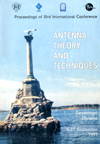Optimization of frequency performances of horn radiators
DOI:
https://doi.org/10.1109/ICATT.1999.1236209Abstract
The main advantages of horn radiators (HA) are flat gain over the frequency range, simplicity of construction and reliability in service. From these qualities the high passband response is the most important one for being extremely essential factor for raising the information carrying capacity of radio lines in different applications. The antenna passband response is determined quantitatively by the range of frequencies within which the antenna parameters are within certain limits. Sometimes the antenna pass-band response is determined by the mismatch factor which represents the reflected wave to incident wave amplitude ratio. The mismatch factor specifies the antenna passband response by the antenna input impedance. It is assumed also that the antenna directivity (shape and width of the main lobe, level of the side lobes) for a wide frequency range varies within the acceptable limits. However, it is, as a rule, rather difficult to formulate a criterion for passband response on the beam pattern characteristics. In each particular case one should proceed from the application of a corresponding radio technical equipment.References
Brueckmann, H.; Hagaman, B. Horn Antennas for HF Long-Range Communication. IRE Tr., 1960, Vol. AP 16, No. 9, p. 523-526.
USP 2283935, Cl. 343-778, pbld. 26.05.42.
WGP 1101535, Cl. 21, Subcl. a4, Gr. 46, Subgr. 01, pbld, 1966.
Fr. Pat. 1290275, Cl. HOIQ, pbld. 01.03.61.
Shumlyanskiy, I.I. Horn Radiators of Complex Configuration. Singapore-London: World Scientific, 1993, 172 p.
Shumlyanskiy, I.I. Horn Radiators with Stepped and Curved Generating Line. Kiyv: Vyssha Shkola, 1986, 147 p. [in Russian].
Published
1999-09-14
Issue
Section
LGA, printed antennas

